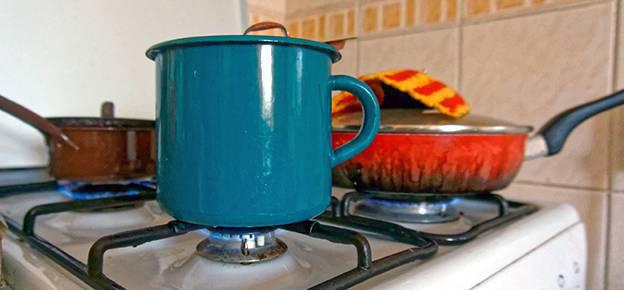First long-term study on particulate matter from 10 nano- to 10 micrometers in apartments in Germany

Credit: Tilo Arnhold, TROPOS
Leipzig/Berlin. Residents of large German cities have it above all in their own hands how high the concentrations of ultrafine dust are in their homes. The level of pollution in the home depends only partially on the air quality outside. However, it also depends very much on activities inside the home, such as cooking activities or heating of solid fuel. This study was led by the Leibniz Institute for Tropospheric Research (TROPOS) commissioned by the Federal Environment Agency (UBA). To this end, fine and ultrafine aerosol particles were measured inside and outside for about two weeks in each of 40 apartments in Leipzig and Berlin during different seasons of the year. The study was published in English in the journal Aerosol and Air Quality Research. It is the first long-term study on aerosol particles in the size range from10 Nano- to 10 Micrometer to be conducted in such detail in many apartments in Germany over such a long period of time.
Fine and ultrafine aerosol particles are important for public health, because of the links with respiratory and cardiovascular diseases. How many particles remain in the body depends, among other things, on the size of the particles. Among the most important sources of ultrafine particles, which are smaller than 100 Nanometer and can therefore penetrate deep into the body, are combustion engines in road and air traffic, small combustion plants, power stations or even forest fires. For this reason, many industrialized countries now have extensive measures in place to reduce particulate matter in the outside air. According to estimates, however, people in the so-called developed countries spend more than two thirds of their lives inside buildings and most of that time in their own homes. At home, they are exposed to a mixture of pollutants that come from indoor sources such as cooking activities or heating, but also from the outside air.
In order to find out to which kind of fine and ultrafine particle the people are exposed in their own homes, TROPOS has been commissioned by the Federal Environment Agency to investigate the indoor pollution in 40 non-smoking houses or apartments in Leipzig and Berlin between 2016 and 2019. Parallel to the indoor measurements, identical measurements were taken either on the balcony, on the terrace or in the garden. To be able to assess the effects of road traffic, about half of the apartments were located within 150 meters of busy roads. Further apartments were selected in the urban background and in outlying districts to map different quality levels of outdoor air. For the research project, the TROPOS team developed special measuring instruments to determine high-resolution particle number size distributions inside and outside the buildings. Over the course of two years, each of the 40 apartments was visited twice with a measuring period of one week in different seasons.
Since it was assumed that the activities of the residents have a major influence on the air quality in the apartment, they were asked to keep a digital logbook in which activities such as airing, cooking, lighting candles or vacuuming were noted. A total of around 10,000 measuring hours were recorded in summer and winter. This was important for the evaluation, as apartments are actively ventilated to varying degrees depending on the outside temperature.
The measurements showed that 90 percent of the number of particles in the houses or apartments were ultrafine and thus smaller than 100 Nanometer. Surprisingly, clear conclusions could be drawn about the indoor activities. Apart from burning candles, significant amounts of ultrafine particles were also released during cooking, baking, and toasting. The particles could also be measured in rooms outside of the kitchen.
In terms of time, the number of ultrafine particles was lowest during the night but peaked in the evening and morning. Especially in winter, when there is less active ventilation, a very clear daily profile was shown: “The particle number concentration in indoor rooms shows strong peaks at 8:00 a.m., 12:00 a.m. and 7:00 p.m., which are typical times for breakfast, lunch and dinner,” explains Jiangyue Zhao from TROPOS, who evaluated the data in the frame of her doctoral thesis.
In summertime, the peaks of ultrafine particles were less pronounced, because or more active ventilation due to open windows. While the largest amounts particles were observed in summer as well as in winter in the evening around 8 pm, the morning peak shifted from around 8 am in summer to around 9 am in winter, which could be related to the fact that people become active later in the day due to the later sunrise in winter.
Prof. Alfred Wiedensohler from TROPOS summarized the results: “The approximately 500 measurement days enabled us to obtain a representative daily and seasonal variation pattern of exposure of fine and ultrafine particles in homes and to analyze the corresponding relationships between indoor and outdoor pollution. Concentrations of ultrafine particles were associated with the activities of residents and showed significantly higher concentrations and greater variability than those form outdoors”.
From the scientific point of view, the exposure to ultrafine particles in German homes cannot be described by outdoor measurements. One reason for this is that the apartments are usually well insulated by modern energy-saving windows and air exchange is only carried out briefly by manual ventilation. In general, a robust dose-effect relationship for ultrafine particulate matter both indoors and outdoors is currently still lacking. As a result, the scientific community will be asked to conduct targeted studies in the coming years to investigate the health effects of indoor ultrafine particulates. Tilo Arnhold
###
Publication:
Jiangyue Zhao, Wolfram Birmili, Birgit Wehner, Anja Daniels, Kay Weinhold, Lina Wang,
Maik Merkel, Simonas Kecorius, Thomas Tuch, Ulrich Franck, Tareq Hussein,
Alfred Wiedensohler (2020): Particle Mass Concentrations and Number Size Distributions in 40 Homes in Germany: Indoor-to-outdoor Relationships, Diurnal and Seasonal Variation. Aerosol and Air Quality Research, 20: 576-589. DOI:10.4209/aaqr.2019.09.0444
https:/
This work was supported by the Federal Ministry for the Environment, Nature Conservation, Building and Nuclear Safety (BMUB) grant UFOPLAN FKZ 3715 61 200 (German title: „Ultrafeine Partikel im Innenraum und in der Umgebungsluft: Zusammensetzung, Quellen und Minderungsmöglichkeiten”).
Media contacts:
Prof Alfred Wiedensohler (de.+en.)
Head of the Department Experimental Aerosol & Cloud Microphysics
Leibniz Institute for Tropospheric Research (TROPOS)
Phone +49 341 2717- 7062
https:/
and
Jiangyue Zhao (en.)
Researcher, Department Experimental Aerosol & Cloud Microphysics
Leibniz Institute for Tropospheric Research (TROPOS)
Phone +49 341 2717- 7385
https:/
or
Tilo Arnhold
Public Relations at the Leibniz Institute for Tropospheric Research (TROPOS), Leipzig, Germany
Phone: +49-341-2717-7189
https:/
Links:
Indoor/outdoor air analysis (2016-2019): Ultrafine particles in indoor and ambient air – composition, sources and mitigation options
https:/
TROPOS long-term studies for particulate air quality
https:/
UBA Indoor Air Hygiene Commission
https:/
Media Contact
Tilo Arnhold
[email protected]
Original Source
https:/
Related Journal Article
http://dx.




